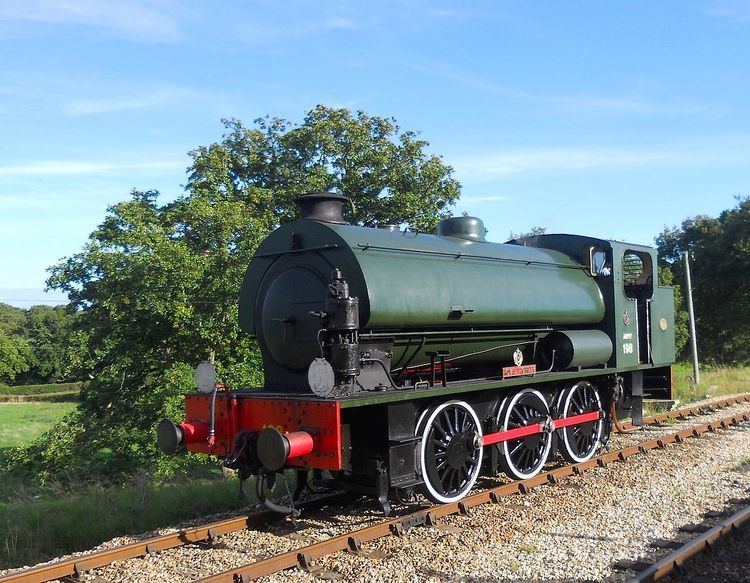Power type Steam Build date 1943–1964 Configuration 0-6-0ST | Total produced 485 | |
 | ||
Builder Hunslet Engine Company,Andrew Barclay Sons & Co. (15),W. G. Bagnall (52),Hudswell Clarke (50), Robert Stephenson and Hawthorns (90),Vulcan Foundry (50) | ||
The Hunslet Engine Company Austerity 0-6-0ST is a steam locomotive designed for shunting. The class became the standard British shunting locomotive during the Second World War, and production continued until 1964 at various locomotive manufacturers.
Contents
Background
The 48150 class were built for the Guest Keen Baldwins Iron & Steel Company in 1937, being an enlarged version of a design dating from 1923. These developed into the 50550 class of 1941–42, with various modifications.
At the outbreak of the Second World War, the War Department had initially chosen the LMS 'Jinty' 3F 0-6-0T as its standard shunting locomotive, but was persuaded by Hunslet that a simplified version of their more modern 50550 design would be more suitable. The first locomotive was completed at their Leeds works at the start of 1943.
Construction
Hunslet subcontracted some of the construction to Andrew Barclay Sons & Co., W. G. Bagnall, Hudswell Clarke, Robert Stephenson and Hawthorns and the Vulcan Foundry in order to meet delivery requirements.
After D-Day they were used on Continental Europe and in North Africa as well as at docks and military sites in Britain.
A total of 377 had been built for the War Department by 1947 (on orders placed during the war), with two further engines having been built for collieries (without the permission of the Ministry of Supply). When the end of the war reduced the need for locomotives, the military started to review its fleet:
Others were sold for industrial use. A number of those used on the continent are believed to have worked on light and industrial railways in France, six going to the Chemins de Fer Tunisiens in 1946. One was used in Valentigney on the Peugeot industrial branch line.
Post-war construction
As the final War Department locomotives were being delivered, the National Coal Board was placing orders for identical locomotives to be used at their collieries. Between 1948 and 1964, 77 new "Austerity" locomotives were built for the NCB. A further fourteen engines were ordered in 1952 by the British Army to supplement its 90 existing engines.
The Yorkshire Engine Company also built eight locomotives to this design in 1954 for use in ironstone quarries and at Scunthorpe Steelworks. It has been suggested, although it has not been proven, that Hunslet sold some of the parts for the eight "Austerities" to the Yorkshire Engine Company as part of a subcontract settlement for the GWR 9400 Class 0-6-0PTs, ordered by the GWR from Hunslet and partially subcontracted to the Yorkshire Engine Company.
Hunslet undertook the rebuilding of many NCB locomotives and when the Army started to sell off locomotives again in 1959, they bought 15 examples that were to be rebuilt and sold on. The NCB bought 13 of these, the 14th was sold directly into preservation and the final locomotive was scrapped without being rebuilt. Ultimately from first to last, a total of 485 examples were constructed between 1943 and 1964.
The NCB continued to use Austerities in the 1970s and a small number remained in service until the early 1980s, notably at Bickershaw Colliery, Greater Manchester. Some of the examples that survived the longest were those fitted with mechanical stokers and Kylpor blast pipes or Giesl ejectors to improve their performance and reduce smoke.
Preservation
56 Austerities have been preserved on heritage railways, many in working order. Several have been painted as LNER Class J94s to represent mainline rather than industrial use. During the "Rocket 150" celebrations in 1979, NCB Bold Colliery "Austerity" No. 7 Robert also participated in the cavalcade of locomotives at Rainhill, marking the only time since 1967 that an "Austerity" has run on the national network.
Not all have survived intact; the boiler of RSH 7135 of 1944 was used on the replica broad gauge locomotive "Iron Duke" built at the National Railway Museum in 1985. A former Hunslet Austerity at the Watercress Line has been rebuilt from an 0-6-0ST into a 0-6-0T Thomas the Tank Engine lookalikes, and another into one of Douglas, also from The Railway Series.
In fiction
This class of engine forms the basis of the characters Wilbert the Forest Engine and Sixteen the Steelworks Engine from The Railway Series children's books by Christopher Awdry. Wilbert is named after the author's father, the Rev. W. Awdry, who created the series; the name was applied to Hunslet 3806, built in 1953, at the Dean Forest Railway by Awdry in 1987.
An Austerity appeared in the film The Great St Trinian's Train Robbery filmed on the Longmoor Military Railway. This loco, No. 3796 Errol Lonsdale, was disguised as British Railways No. 68011 for filming. It was subsequently preserved on the Mid Hants Railway and later on the South Devon Railway, but has since been sold abroad to private owners and is currently based at the Maldegem Railway Museum in Belgium.
Models
The Hunslet "Austerity" was produced as a model by Kitmaster from 1961 onwards in 00 gauge. The Kitmaster toolings were sold to Airfix in 1962 and later Dapol in 1981 when Airfix stopped production of model railway items; Dapol continued to use the Kitmaster toolings until they were destroyed by a fire at Dapol's Winsford headquarters in 1994. Dapol subsequently created a replacement moulding to allow production of these locomotives; this tooling was sold in 1996 to Hornby who have continued to produce the "Austerity" as both the J94 class and in various industrial liveries.
Graham Farish and subsequently Bachmann have produced the "Austerity" as the LNER/BR J94 class for N gauge.
DJmodels now produces J94 and austerity tanks in 00 gauge in a variety of liveries including BR as well as several industrial liveries.
